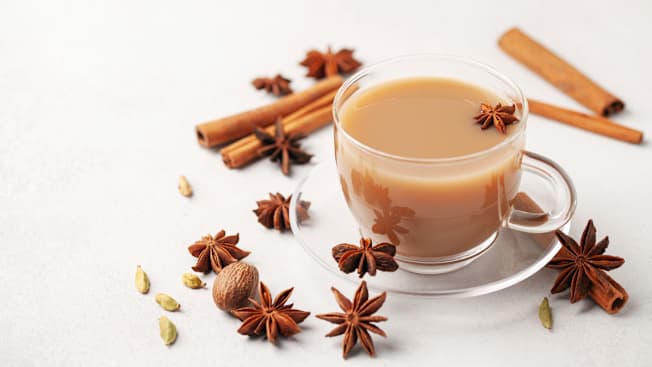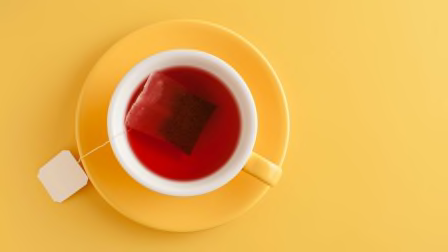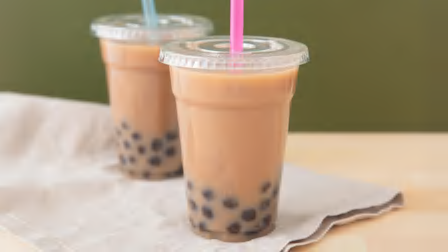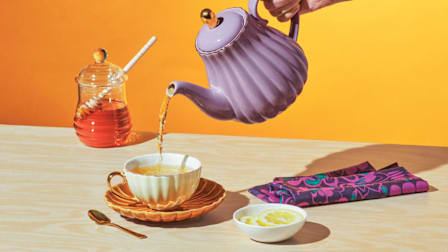What Is Chai—and Is It Good for You?
There’s a big difference between traditional versions of this spiced tea and what you usually find at coffee shops

Chai tea is a spiced drink that originated in India and is now a fixture on many coffeehouse menus. The name is a bit of a misnomer. Chai is the Hindi word for tea—any kind—so chai tea really means “tea tea.” The more accurate term is masala chai, a mixture of spices (masala) and tea (chai).
And the name isn’t the only thing that separates traditional masala chai from the chai tea latte Starbucks introduced in the late 1990s or the versions that are now served at many coffee shops. The former is a basic combination of black tea leaves and spices blended with milk and sweetener. The latter is often made from presweetened bottled concentrates or powdered creamerlike blends. Not surprisingly, the nutritional benefits and drawbacks as well as the flavor are very different.
The Origins of Masala Chai
Spiced beverages have existed in India in one form or another for thousands of years, says Nandita Godbole, author of “Seven Pots of Tea: An Ayurvedic Approach to Sips & Nosh” (Turmeric Press, 2020). Herbs and spices were blended according to Ayurvedic principles (Ayurveda is the traditional system of medicine in India) and brewed with water. People would sip these drinks as part of their health regimens.
Masala Chai Benefits
The building blocks of masala chai have some pretty solid health benefits.
Black tea is rich in powerful health-promoting antioxidants called polyphenols, says Shailee Saran Varanasi, MS, RDN, an adjunct health and nutrition instructor at Logan University in Chesterfield, Mo. These compounds have been linked to a reduced risk of health problems, such as heart disease and type 2 diabetes. Sipping black tea can help you feel alert with less jitteriness than java. In addition to being lower in caffeine than coffee, black tea contains a compound called l-theanine, which balances the impact of caffeine. (You can also use decaf black tea to make masala chai.)
Spices vary depending on who’s doing the brewing, but black pepper, cardamom, cinnamon, cloves, ginger, and star anise are some of the ones most used in masala chai. Spices can be a good source of antioxidants. When scientists ranked the antioxidant levels in more than 3,000 foods, they found that several herbs and spices—such as allspice, cinnamon, cloves, and peppermint—came out on top. Some spices may have other health benefits, Varanasi says. For instance, cardamom may help with digestion, while cloves may have antimicrobial properties.
Milk adds protein and calcium. (In India, water buffalo milk is often used, but because that’s not generally available in the U.S., cow’s milk, usually whole milk, is standard.) While the teaspoon or two you’d add to a regular cup of tea wouldn’t have much of these nutrients, in chai you could be drinking one-quarter to one-half cup. That amount of whole milk provides 2 to 4 grams of protein and 78 to 155 mg of calcium, as much as 15 percent of the Daily Value (1,000 mg).
Sweetener is standard. But you don’t need to add much. You can use sugar, agave, honey, or jaggery (an unrefined sugar popular in India, it’s similar to raw cane sugar). Just keep the American Heart Association’s recommendations for added sugars in mind; no more than 25 grams per day for women and no more than 36 grams for men. Sugar substitutes are an option, but they may not be much better for you than sugar. Some research has linked them to an increased risk of certain cancers, heart disease, diabetes, and more.
The Lesser Chais
“Premade chai concentrates and powders are convenient but could be high in sugar and calories,” Varanasi says. For example, three-fourths of a cup of Oregon Original Chai Tea Latte Concentrate has 130 calories and 31 grams (nearly 8 teaspoons) of added sugar. You could use less of it, but that may lead to a weak-tasting brew. There are lower-sugar options, such as Dona Masala Chai, with 10 grams (around 2½ teaspoons) in a half-cup serving. Some brands offer unsweetened versions, but watch for those labeled sugar-free. That often means the product contains a sugar substitute such as sucralose.
And, Varanasi says, these products often don’t contain as much tea or the same concentration of spices as traditionally brewed masala chai, so you may not be getting the same benefits or flavor.
Chai It On for Size
Using a chai teabag can be a healthier option; most are just a mix of black tea and spices. Like regular tea, you steep it in hot water and add your own milk and sweetener. Or consider brewing your own masala chai from scratch. “It takes 5 minutes and can become an exercise in mindfulness for yourself,” Godbole says. Here’s her recipe for a perfect cup:
Combine ¾ cup of water, 1 tsp. of black tea leaves (Assam, Nilgiri Black, or Darjeeling are traditional), and sugar or another sweetener to taste in a small pot. (If sweetening with honey, wait until just before serving to add it.) Add a pinch or two of a masala blend or a small amount of different spices you like, such as a sliver of ginger, a cardamom pod, and a pinch of cinnamon
Bring to a boil. Lower the heat, add ¼ cup of dairy milk, and bring to a second boil. (Plant milks will separate if you heat them this way. If you prefer nondairy milk, pour it into a cup and top it with the brewed tea and spices.)
At this point, you can strain the tea-milk mixture into a cup. For a more concentrated flavor, reduce the heat and let it simmer on low for a minute more before straining into a cup.




















